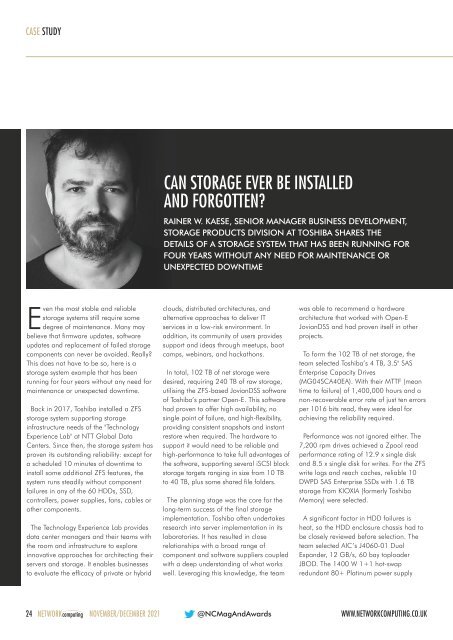NC Nov-Dec 2021
You also want an ePaper? Increase the reach of your titles
YUMPU automatically turns print PDFs into web optimized ePapers that Google loves.
CASE STUDY<br />
CAN STORAGE EVER BE INSTALLED<br />
AND FORGOTTEN?<br />
RAINER W. KAESE, SENIOR MANAGER BUSINESS DEVELOPMENT,<br />
STORAGE PRODUCTS DIVISION AT TOSHIBA SHARES THE<br />
DETAILS OF A STORAGE SYSTEM THAT HAS BEEN RUNNING FOR<br />
FOUR YEARS WITHOUT ANY NEED FOR MAINTENA<strong>NC</strong>E OR<br />
UNEXPECTED DOWNTIME<br />
Even the most stable and reliable<br />
storage systems still require some<br />
degree of maintenance. Many may<br />
believe that firmware updates, software<br />
updates and replacement of failed storage<br />
components can never be avoided. Really?<br />
This does not have to be so, here is a<br />
storage system example that has been<br />
running for four years without any need for<br />
maintenance or unexpected downtime.<br />
Back in 2017, Toshiba installed a ZFS<br />
storage system supporting storage<br />
infrastructure needs of the "Technology<br />
Experience Lab" at NTT Global Data<br />
Centers. Since then, the storage system has<br />
proven its outstanding reliability: except for<br />
a scheduled 10 minutes of downtime to<br />
install some additional ZFS features, the<br />
system runs steadily without component<br />
failures in any of the 60 HDDs, SSD,<br />
controllers, power supplies, fans, cables or<br />
other components.<br />
The Technology Experience Lab provides<br />
data center managers and their teams with<br />
the room and infrastructure to explore<br />
innovative approaches for architecting their<br />
servers and storage. It enables businesses<br />
to evaluate the efficacy of private or hybrid<br />
clouds, distributed architectures, and<br />
alternative approaches to deliver IT<br />
services in a low-risk environment. In<br />
addition, its community of users provides<br />
support and ideas through meetups, boot<br />
camps, webinars, and hackathons.<br />
In total, 102 TB of net storage were<br />
desired, requiring 240 TB of raw storage,<br />
utilising the ZFS-based JovianDSS software<br />
of Toshiba’s partner Open-E. This software<br />
had proven to offer high availability, no<br />
single point of failure, and high-flexibility,<br />
providing consistent snapshots and instant<br />
restore when required. The hardware to<br />
support it would need to be reliable and<br />
high-performance to take full advantages of<br />
the software, supporting several iSCSI block<br />
storage targets ranging in size from 10 TB<br />
to 40 TB, plus some shared file folders.<br />
The planning stage was the core for the<br />
long-term success of the final storage<br />
implementation. Toshiba often undertakes<br />
research into server implementation in its<br />
laboratories. It has resulted in close<br />
relationships with a broad range of<br />
component and software suppliers coupled<br />
with a deep understanding of what works<br />
well. Leveraging this knowledge, the team<br />
was able to recommend a hardware<br />
architecture that worked with Open-E<br />
JovianDSS and had proven itself in other<br />
projects.<br />
To form the 102 TB of net storage, the<br />
team selected Toshiba’s 4 TB, 3.5" SAS<br />
Enterprise Capacity Drives<br />
(MG04SCA40EA). With their MTTF (mean<br />
time to failure) of 1,400,000 hours and a<br />
non-recoverable error rate of just ten errors<br />
per 1016 bits read, they were ideal for<br />
achieving the reliability required.<br />
Performance was not ignored either. The<br />
7,200 rpm drives achieved a Zpool read<br />
performance rating of 12.9 x single disk<br />
and 8.5 x single disk for writes. For the ZFS<br />
write logs and reach caches, reliable 10<br />
DWPD SAS Enterprise SSDs with 1.6 TB<br />
storage from KIOXIA (formerly Toshiba<br />
Memory) were selected.<br />
A significant factor in HDD failures is<br />
heat, so the HDD enclosure chassis had to<br />
be closely reviewed before selection. The<br />
team selected AIC’s J4060-01 Dual<br />
Expander, 12 GB/s, 60 bay toploader<br />
JBOD. The 1400 W 1+1 hot-swap<br />
redundant 80+ Platinum power supply<br />
24 NETWORKcomputing NOVEMBER/DECEMBER <strong>2021</strong> @<strong>NC</strong>MagAndAwards<br />
WWW.NETWORKCOMPUTING.CO.UK

















